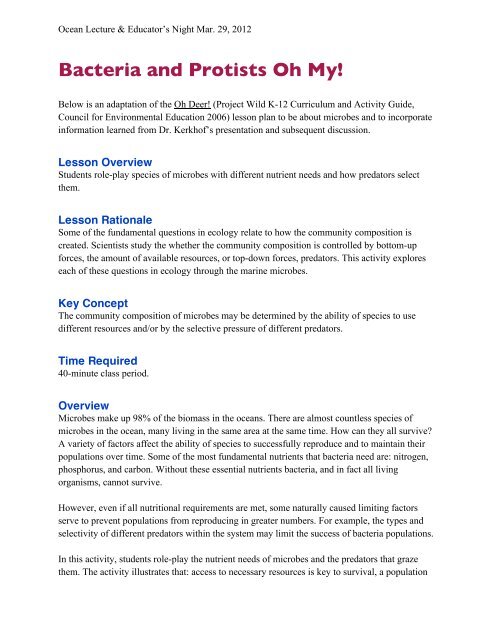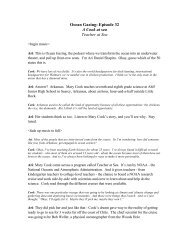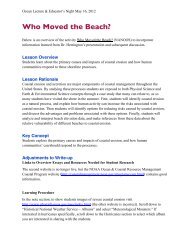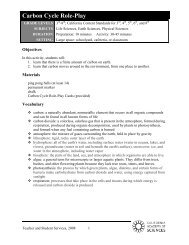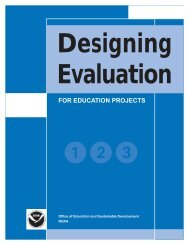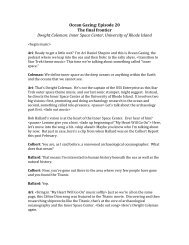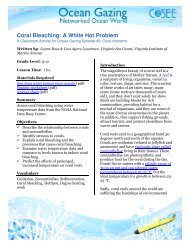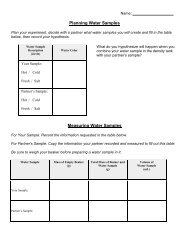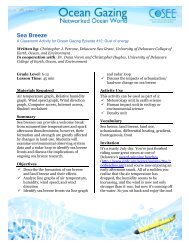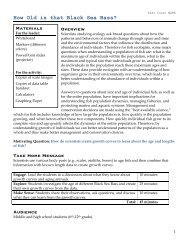Bacteria and Protists Oh My - v2 - cosee now
Bacteria and Protists Oh My - v2 - cosee now
Bacteria and Protists Oh My - v2 - cosee now
You also want an ePaper? Increase the reach of your titles
YUMPU automatically turns print PDFs into web optimized ePapers that Google loves.
Ocean Lecture & Educator’s Night Mar. 29, 2012<br />
<strong>Bacteria</strong> <strong>and</strong> <strong>Protists</strong> <strong>Oh</strong> <strong>My</strong>!<br />
Below is an adaptation of the <strong>Oh</strong> Deer! (Project Wild K-12 Curriculum <strong>and</strong> Activity Guide,<br />
Council for Environmental Education 2006) lesson plan to be about microbes <strong>and</strong> to incorporate<br />
information learned from Dr. Kerkhof’s presentation <strong>and</strong> subsequent discussion.<br />
Lesson Overview<br />
Students role-play species of microbes with different nutrient needs <strong>and</strong> how predators select<br />
them.<br />
Lesson Rationale<br />
Some of the fundamental questions in ecology relate to how the community composition is<br />
created. Scientists study the whether the community composition is controlled by bottom-up<br />
forces, the amount of available resources, or top-down forces, predators. This activity explores<br />
each of these questions in ecology through the marine microbes.<br />
Key Concept<br />
The community composition of microbes may be determined by the ability of species to use<br />
different resources <strong>and</strong>/or by the selective pressure of different predators.<br />
Time Required<br />
40-minute class period.<br />
Overview<br />
Microbes make up 98% of the biomass in the oceans. There are almost countless species of<br />
microbes in the ocean, many living in the same area at the same time. How can they all survive<br />
A variety of factors affect the ability of species to successfully reproduce <strong>and</strong> to maintain their<br />
populations over time. Some of the most fundamental nutrients that bacteria need are: nitrogen,<br />
phosphorus, <strong>and</strong> carbon. Without these essential nutrients bacteria, <strong>and</strong> in fact all living<br />
organisms, cannot survive.<br />
However, even if all nutritional requirements are met, some naturally caused limiting factors<br />
serve to prevent populations from reproducing in greater numbers. For example, the types <strong>and</strong><br />
selectivity of different predators within the system may limit the success of bacteria populations.<br />
In this activity, students role-play the nutrient needs of microbes <strong>and</strong> the predators that graze<br />
them. The activity illustrates that: access to necessary resources is key to survival, a population
will continue to increase in size until some limiting factors are imposed, <strong>and</strong> limiting factors<br />
contribute to fluctuations in populations.<br />
Students are transformed into different marine bacteria for the simulation. They each need<br />
multiple nutrients to survive <strong>and</strong> divide (reproduce). Through many rounds of gathering nutrients<br />
they will they graph their results <strong>and</strong> compare their population success over time. Then a<br />
predator, a type of protist, will be added to the system <strong>and</strong> the students will repeat the simulation.<br />
Students discover that populations of bacteria fluctuate based upon both the available nutrients<br />
(bottom-up control) <strong>and</strong> the presence <strong>and</strong> abundance of predators (top-down control).<br />
Materials Needed<br />
For the class:<br />
• An area – indoor or outdoor – large enough for the students to run around<br />
• Flipchart with graphs<br />
• Writing utensils (at least two colors)<br />
Preparation<br />
1. Prepare the flipchart graph for the class data. You should make two copies, the first with<br />
Number of <strong>Bacteria</strong> <strong>and</strong> the second with Population Size for the x-axis.
2. Mark two parallel lines about 10-20 meters apart in the space that you will use for the<br />
activity (see image below). Mark a third line perpendicular to the two parallel lines <strong>and</strong><br />
off to the side in the same space.<br />
Procedure<br />
Introduction to Simulation<br />
1. Tell students that they will be participating in an activity that emphasizes some of the<br />
most essential things bacteria need to survive. Review the essential nutrients with the<br />
students: nitrogen, phosphorus, <strong>and</strong> carbon.<br />
2. Ask the students to count off in fours. Have all of the ones line up behind one line; the<br />
rest of the students (2s-4s) line up behind the other line, facing the ones.<br />
3. The ones become “bacteria.” All bacteria need nutrients to survive. Again, ask the<br />
students what the essential nutrients are (nitrogen, phosphorus, <strong>and</strong> carbon). The bacteria<br />
(the ones) need to find nitrogen, phosphorus, <strong>and</strong> carbon to survive <strong>and</strong> reproduce. When<br />
a bacteria is looking for nitrogen, it should st<strong>and</strong> with its h<strong>and</strong>s by his/her side. When it is<br />
looking for phosphorus, it should put his/her h<strong>and</strong>s on his/her hips <strong>and</strong> stick out his/her<br />
elbows. Finally, when it is looking for carbon, it should make a giant “C” above his/her<br />
head with his/her arms. A bacteria can choose to look for anyone of these nutrients each<br />
round of the activity. The bacteria cannot change what it is looking for within a round
(e.g., when it sees what is available during that round). It can only change what it is<br />
looking for in the next round, if it survives. <strong>Bacteria</strong>l cells in fact need all three of these<br />
essential nutrients for survival, so the students acting as bacteria must change which<br />
nutrient they choose between each round.<br />
4. The twos, threes, <strong>and</strong> fours are the nutrients. Each student should choose at the beginning<br />
of each round what nutrient component he or she will be during the round. The students<br />
depict which nutrient they are in the same way as the bacteria show what they are looking<br />
for (i.e., placement of h<strong>and</strong>s).<br />
5. The activity starts with all players lined up behind their respective lines (bacteria on one<br />
side <strong>and</strong> nutrients on the other) – <strong>and</strong> with their backs facing each other.<br />
The Simulation Scenario 1 – Only <strong>Bacteria</strong><br />
1. Record the number of bacteria at time 0 (start of the activity) on the flipchart graph.<br />
2. Begin the first round by asking all of the students to make their signs – each bacteria<br />
deciding what it is looking for <strong>and</strong> each nutrient deciding which it will be for that round.<br />
Give the students a few moments to put their h<strong>and</strong>s in place.<br />
3. When the students are ready, say, “<strong>Bacteria</strong> <strong>Oh</strong> <strong>My</strong>!” Each bacteria <strong>and</strong> nutrient should<br />
turn to face each other while holding their h<strong>and</strong>s in place.<br />
4. When bacteria see the nutrient that they need, they should run (or walk) to it. Each<br />
bacteria must hold the sign of what it is looking for until getting to the nutrient student<br />
with the same sign. When the bacteria reaches a nutrient that it needs, he/she should take<br />
the nutrient back to the bacteria line. “Capturing” a nutrient represents the bacteria<br />
successfully meeting its needs <strong>and</strong> successfully reproducing as a result. Any bacteria that<br />
fails to find a nutrient, dies <strong>and</strong> becomes part of the nutrient pool. That is, any bacteria<br />
that died will be a nutrient in the next round <strong>and</strong> so available as a nutrient to the bacteria<br />
that are still alive.<br />
5. Record the number of bacteria at the end of the round on the flipchart graph. Continue the<br />
activity for approximately 10-15 rounds.<br />
Making Sense of the Data<br />
1. At end the of 10-15 rounds, bring the students together to discuss the activity. Encourage<br />
them to talk about what they experienced <strong>and</strong> saw.<br />
2. Use the flipchart graph to have the students look at the data from the activity. The<br />
number of bacteria at the beginning of the activity <strong>and</strong> at the end of each round represents<br />
the number of bacteria in a series of hours. That is, the beginning of the activity is hour<br />
one; each round is an additional hour. The students will see this visual reminder of what<br />
they experienced during the activity: the bacteria population fluctuated over a period of<br />
hours. This process is natural as long as the factors that limit the population do not<br />
become excessive to the point where the bacteria cannot successfully reproduce. The<br />
populations will tend to peak, decline, <strong>and</strong> rebuild; peak, decline, <strong>and</strong> rebuild – as long as<br />
there are enough nutrients <strong>and</strong> sufficient numbers of bacteria to reproduce.
3. Ask your students, what is realistic <strong>and</strong> unrealistic about this simulation (<strong>Bacteria</strong> that<br />
do not survive do become recycled as nutrients but not instantaneously. <strong>Bacteria</strong> need all<br />
three nutrients to survive. Other environmental conditions can affect the survival rate of<br />
bacteria.)<br />
The Simulation Scenario 2 –<strong>Bacteria</strong> & <strong>Protists</strong><br />
1. Introduce the protist as a predator in the system (choose one student in the class to be the<br />
first protist). The protist starts in the designated “predator” area off to the side of the<br />
game space (behind the line perpendicular to the other two lines). The protist needs living<br />
bacteria, so he/she can tag a bacteria only when the bacteria is going toward the nutrients<br />
<strong>and</strong> are between the bacteria <strong>and</strong> nutrient lines. Once a bacteria has been tagged by the<br />
protist, the protist escorts the bacteria back to the “predator” area. Because the protist was<br />
able to get a bacteria he/she was able to reproduce, so the bacteria becomes another<br />
protist. <strong>Protists</strong> that fail to tag a bacteria die <strong>and</strong> become nutrients. That is, in the next<br />
round the protist that died joins the nutrient line. They will become available to surviving<br />
bacteria.<br />
2. Record the number of bacteria <strong>and</strong> the number of protists at time 0 (start of the activity)<br />
on the flipchart graph.<br />
3. Repeat the simulation like in the first scenario, but also allowing protists to tag the<br />
bacteria.<br />
4. Record the number of bacteria <strong>and</strong> protists at the end of the round on the flipchart graph.<br />
Continue the activity for approximately 10-15 rounds.<br />
Wrap-Up<br />
1. Use the flipchart graph to have the students look at the data from the activity. The<br />
students will see this visual reminder of what they experienced during the activity: the<br />
bacteria <strong>and</strong> protists populations fluctuated over a period of hours. Ask the students if<br />
they see a pattern in the data between the bacteria <strong>and</strong> protists populations (the peaks <strong>and</strong><br />
declines in the protist population will be delayed from the bacteria population).<br />
2. In discussion, ask the students to summarize some of the things they learned from this<br />
activity. What nutrients do bacteria need to survive How does the availability of these<br />
nutrients affect the population size of bacteria over time What are some “limiting<br />
factors” that affect the survival of bacteria How do these factors affect competition<br />
within a species <strong>and</strong> among species What is the affect of predators on the population<br />
size of bacteria Are populations of organisms static, or do they tend to fluctuate


